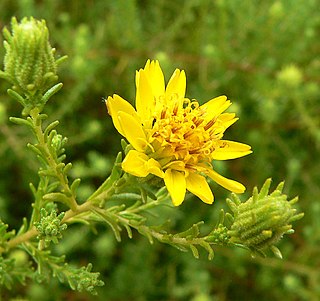
Hemizonia is a genus of plants in the daisy family (Asteraceae). They are known generally as tarweeds, although some tarweeds belong to other genera, such as Madia and Deinandra. Furthermore, Hemizonia is currently being revised; some species may be segregated into new genera.
Hazardia cana is a rare North American species of shrubs in the family Asteraceae known by the common names Guadalupe hazardia, San Clemente Island hazardia, or simply island hazardia. It is native to San Clemente Island, one of the Channel Islands of California, and to Guadalupe Island.

Isocoma menziesii is a species of flowering plant in the daisy family, known by the common name Menzies' goldenbush.

Deinandra is a genus of tarweeds in the daisy family. Such a genus is not recognized as distinct by all authorities; its species are often treated as members of genus Hemizonia.
Deinandra bacigalupii is a rare species of flowering plant in the aster family, Asteraceae, known by the common names Livermore tarplant and Livermore moonshine. It is endemic to Alameda County, California, where there are only about five known occurrences around Livermore. It grows in open areas with alkali soils, such as alkali sinks and meadows. This plant was previously included within Deinandra increscens ssp. increscens, but it was separated and elevated to species level in 1999.

Deinandra conjugens is a rare species of flowering plant in the aster family known by the common names Otay tarplant and Otay tarweed. It is native to a small section of far northern Baja California in Mexico, its range extending north into San Diego County, California, in the United States. One isolated population has been reported from the hills east of Cayucos in San Luis Obispo County.
Deinandra increscens is a species of flowering plant in the aster family known by the common name grassland tarweed. It is endemic to California, where it has been found primarily in Monterey, San Luis Obispo and Santa Barbara Counties. A few isolated populations have been reported from Kern and Merced Counties, but these are from urban areas and probably represent cultivated specimens.

Deinandra fasciculata, known by the common names clustered tarweed and fascicled spikeweed, is a species of flowering plant in the daisy family native to western North America.

Deinandra minthornii — — is a rare California species of flowering plant in the aster family known by the common name Santa Susana tarplant, or Santa Susana tarweed. It is an endangered species, listed as a Threatened species by the California Department of Fish and Game, as Imperiled under the California Endangered Species Act—CESA, and on the California Native Plant Society Inventory of Rare and Endangered Plants of California.
Deinandra mohavensis is a species of flowering plant in the aster family known by the common name Mojave tarplant, or Mojave tarweed.

Centromadia pungens, the common spikeweed or common tarweed, is a species of North American plants in the tarweed tribe within the sunflower family. It is native to northern Baja California and the western United States. The plant is considered a noxious weed in parts of the Pacific Northwest.
Centromadia parryi is a species of North American plants in the tarweed tribe within the sunflower family. It is native to California and, northern Baja California.
Deinandra corymbosa is a rare North American species of plants in the tarweed tribe within the sunflower family. A common name is coastal tarweed.
Deinandra greeneana is a rare North American species of plants in the tarweed tribe within the.
Deinandra palmeri is a rare North American species of plants in the tarweed tribe within the.
Deinandra martirensis is a rare North American species of plants in the tarweed tribe within the sunflower family.

Deinandra kelloggii, Kellogg's spikeweed or Kellogg's tarweed, is a North American species of plants in the tarweed tribe within the. It is native to Baja California, southern and central California, and Arizona.
Deinandra pentactis, the Salinas River tarweed, is a North American species of plants in the tarweed tribe within the. It is endemic to California, found in the Coast Ranges of San Benito, Monterey, San Luis Obispo, and northern Santa Barbara Counties.
Deinandra halliana, or Hall's tarplant, is a California species of plants in the tarweed tribe within the sunflower family. It has been found in the Coast Ranges of Central California, in Monterey, Fresno, San Benito, and San Luis Obispo Counties.
Deinandra pallida, the Kern tarweed, is a California species of plants in the tarweed tribe within the sunflower family. It has been found in the Coast Ranges, southern San Joaquin Valley, and Sierra Nevada foothills in Kern, Los Angeles, Santa Barbara, San Luis Obispo, Tulare, and Kings Counties. Isolated populations have been reported from farther north in Tuolumne County and northwestern Fresno County.






